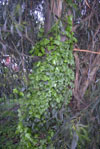Cape ivy (German Ivy)Delairea odorata (synonym Senecio mikanioides) |
||||
|
|
Click on thumbnails
for larger view |
|||
BackgroundIdentification
Identification key in: Hickman, J. ed. 1993. The Jepson Manual: Higher Plants of California. University of California Press. Growth and spread
Habitat
Impacts
Prevention and ControlPrevention
General control notes
Manual or mechanical control(Bossard 2000)
Biological control
Chemical control
References and more information
Balciunas, J. 2003. Biological control of Cape Ivy Research Report (April
2002 through December 2002). United States Department of
Agriculture, Agricultural Research Service. Albany, CA. Available at
http://groups.ucanr.org/ceppc/Progress_in_Cape_ivy_biocontrols/.
Bossard, C. 2000. Delairea odorata. In Invasive Plants of California Wildlands. Carla C. Bossard, John M. Randall, Marc C. Hoshovsky, Editors. University of California Press. Available at http://groups.ucanr.org/ceppc/Invasive_Plants_of_California's_Wildlands . Gibbons, M.V., M.G. Rosenkranz, H.L. Gibbons, Jr., and M.D. Sytsma. 1999. Guide for Developing Integrated Aquatic Vegetation Management in Oregon. Center for Lakes and Reservoirs, Portland State University, Portland, OR. Management of Cape-ivy ( Delairea odorata) in the Golden Gate National Recreation Area. Maria Alvarez. 1997. Proceedings of the 1997 CalEPPC Symposium. CalEPPC, Sacramento, CA.
|
||||
| This page has been accessed | times. |




